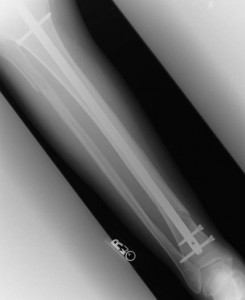However much protective clothing you wear (read our guide here), there’s always the risk of injury if you come off your motorbike at speed – you can only minimise the risk, not eliminate it. The Hurt Report found that 98% of multiple vehicle collisions and 96% of single vehicle motorbike accidents resulted in some kind of injury, with 45% of those being more than a minor injury. 75% of motorbike accidents are collisions with other vehicles, and other vehicles are solid. Here are the most common injuries suffered by motorbike riders and how you can minimise ther risk.
Road rash
Tarmac will wear through jeans in a matter of a couple of seconds. When it reaches your skin it will strip it off down to the flesh causing nerve damage that can cause ongoing pain for years. You will have to have skin grafts if the grazes are bad enough, and they can be disfiguring. Significant blood loss can occur. While you can get kevlar jeans, they are not as good as proper motorcycle trousers which will have padding to help cushion a fall.
Types of injuries causes by road burn or road rash
- Avulsion injuries – these are injuries where the underlying muscles and fat are exposed.
- Compression injuries – these are injuries that can cause bruises and haematomas.
- Cuts – open wounds that require stitches, or bandages.
If you have to have skin grafts it is extremely painful.
This video explains how a skin graft works in an animation. If you want to search actual skin graft operations or the results of motorbike crashes, have a look on YouTube.
Hearing damage
Riders that ride noisy bikes, especially those without a muffler, often expose themselves to volumes in excess of 95dB. At this level, hearing is irreparably damaged at around one hour in. Long-term riders report tinnitus and reduced ability to hear high frequencies which can cause problems in understanding conversations.
Head injuries
Even though you will be wearing a helmet, the helmet can only cushion the impact so much. Injuries to the brain are caused by a rapid deceleration of the head which slams the brain into the inside of the skull. At the low end it will cause concussion and at the high end it can cause permanent loss of cognitive (brain) functions.
Traumatic brain injuries can lead to a lifetime of dependence on loved ones.
The symptoms of a concussion can include one or more of the following, and they can last for days, weeks or months depending on the severity of the concussion:
- Headache
- Vomiting
- Dizziness and difficult balancing
- Sensitivity to light and noise
- Confusion, memory loss (amnesia) and problems concentrating
- Loss of consciousness
- Slurred speed and blurred vision
- Ringing ears
- Irritability
- Problems sleeping
- Epilepsy.
More information about concussion is here.
This article shows you where the most common impacts are. For riders that don’t wear a full face helmet, they are risking significant facial disfigurement.
Eye injuries
Riders that don’t wear a visor or sunglasses can be hit in the eye by insects and stones flicked up from other vehicles. These can impact they eye at over 50kph and can cause blindness.
When a rider has a high speed impact that stops the head abruptly, the eye can come out of the socket. Other impacts can cause damage around the orbital socket.
The best protection is a full face helmet with the visor down.
Spine and neck injuries
Spinal injuries can cause paralysis in the worst case, and restricted movement with a long period of convalescence in the best case. Use a spine protector or other type of body armour. These will spread any impact on your spine and help cushion any impacts.
Broken bones
 High speed impacts into immovable objects often result in broken bones. They can take a long time to heal and you can be left with debilitating injuries.
High speed impacts into immovable objects often result in broken bones. They can take a long time to heal and you can be left with debilitating injuries.
In a frontal impact your femur (thigh) or tibia (shin) can hit the handlebars causing a nasty break. Boots with shin guards can help prevent this. If the break is bad enough you may need to have pins in your bones to hold them together.
Wrists are also commonly broken either if the rider doesn’t let go of the handlebars in time in a frontal impact, or as the rider puts his hands out before an impact.
Collar bones are commonly broken when the rider lands on the road sideways and the friction of the road wrenches the shoulder inwards. This can cause ‘biker’s arm’ which when the nerves are damaged in the upper arm and cause ongoing pain and tingling.
It’s common in higher speed accidents for a rider to fracture or break the pelvis.
Internal injuries and bleeding
Motorbike handlebars can cause significant internal injuries if one hits you in the stomach in a crash, let alone whatever you hit before you eventually stop.
Groin injuries
As the petrol tank is right in front of a rider’s groin, a frontal impact can cause the groin to hit the tank.
How can you minimise your chances of injury in a motorbike crash?
Scanning and looking for exits
Good riders are constantly scanning the road ahead for potential dangers and looking for places they can exit.
Keeping fit and flexible
The fitter you are, the more resilient you will be in a crash. The more flexible you are the less likely you are to break bones or tear tendons and muscles.
Keeping your speed down
The chance of injury increases exponentially with speed. Keep your distance behind the vehicle in front and adjust your road position to be as visible as possible.
There’s more information here about motorbike injuries.
